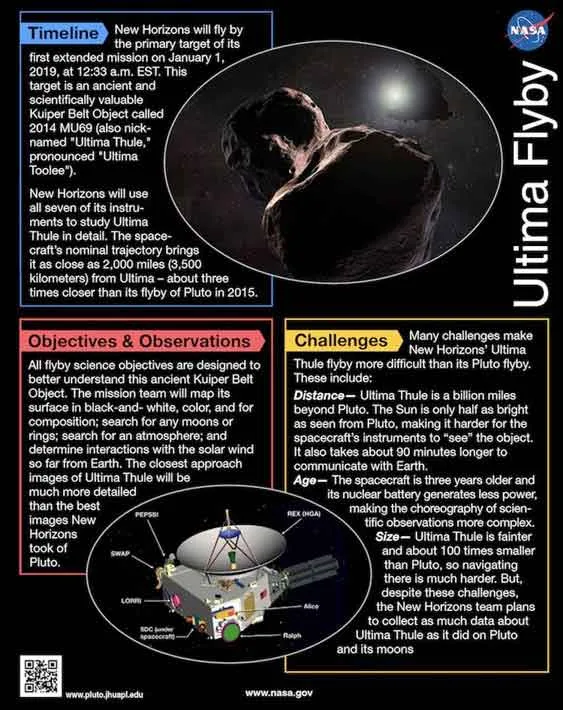
A little after midnight on New Year's Day, NASA's New Horizons space probe will fly by a Kuiper Belt object officially called 2014 MU69. The object is also known as Ultima Thule in more common parlance and New Horizons will swing as close as 2,000 miles (3,200 km) from the surface of the object. This is part of the extended mission of New Horizons that was the first probe to visit Pluto in 2015.
Ultima Thule is part of the Kuiper Belt. The Kuiper Belt is made up of dwarf planets, like Pluto, that are scattered out past Neptune. The Kuiper Belt extends roughly just past Neptune's orbit at 30 astronomical units (AU) or 30 times the distance Earth is from the Sun out to 50 AU or so. Pluto is the closest member of the Kuiper Belt, but not the only one. Others include Quaoar, Makemake, Eris, Sedna, Orca and many, many more.
New Horizons was originally designed to visit what was thought to be last planet in the solar system. The mission was selected for the New Frontiers program in 2001. The probe was launched in 2006 and made its flyby of Pluto in 2015. The intent was to have all the planets of the solar system visited by American spacecraft, but once the effort had been started to go to Pluto with the robotic space probe other dwarf planets were found out in the then hypothetical Kuiper Belt. After New Horizons was launched, astronomers, in a very contentious decision, downgraded Pluto from being a planet to a dwarf planet: when it was realized there were potentially hundreds of dwarf planets out there, a separate category was created.
After New Horizons visited Pluto, it was designed to make use of the probe again and redirect it to another member of the Kuiper Belt. Ultima Thule was selected and in a little over 24 days, New Horizons will help tell us whether or not Pluto is a typical member of the Kuiper Belt, as suspected, or a unique one.
Whether NASA plans on attempting to use New Horizons after the Ultima Thule encounter remains to be seen. If so, it remains functioning long enough, it will encounter the Heliopause, the point where interstellar gases push back on the solar wind and marks interstellar space. The American Voyager spacecraft are the only other ones to have encountered this to date.
New Horizons
http://pluto.jhuapl.edu/
New Horizons
https://en.wikipedia.org/wiki/New_Horizons
Kuiper Belt
https://en.wikipedia.org/wiki/Kuiper_belt
Ultima Thule
https://en.wikipedia.org/wiki/(486958)_2014_MU69
Trans-Neptunian Object
https://en.wikipedia.org/wiki/Trans-Neptunian_object
Makemake
https://en.wikipedia.org/wiki/Makemake
50000 Quaoar
https://en.wikipedia.org/wiki/50000_Quaoar
Heliopause/heliosphere
https://en.wikipedia.org/wiki/Heliosphere
Voyager spacecraft
https://en.wikipedia.org/wiki/Voyager_program